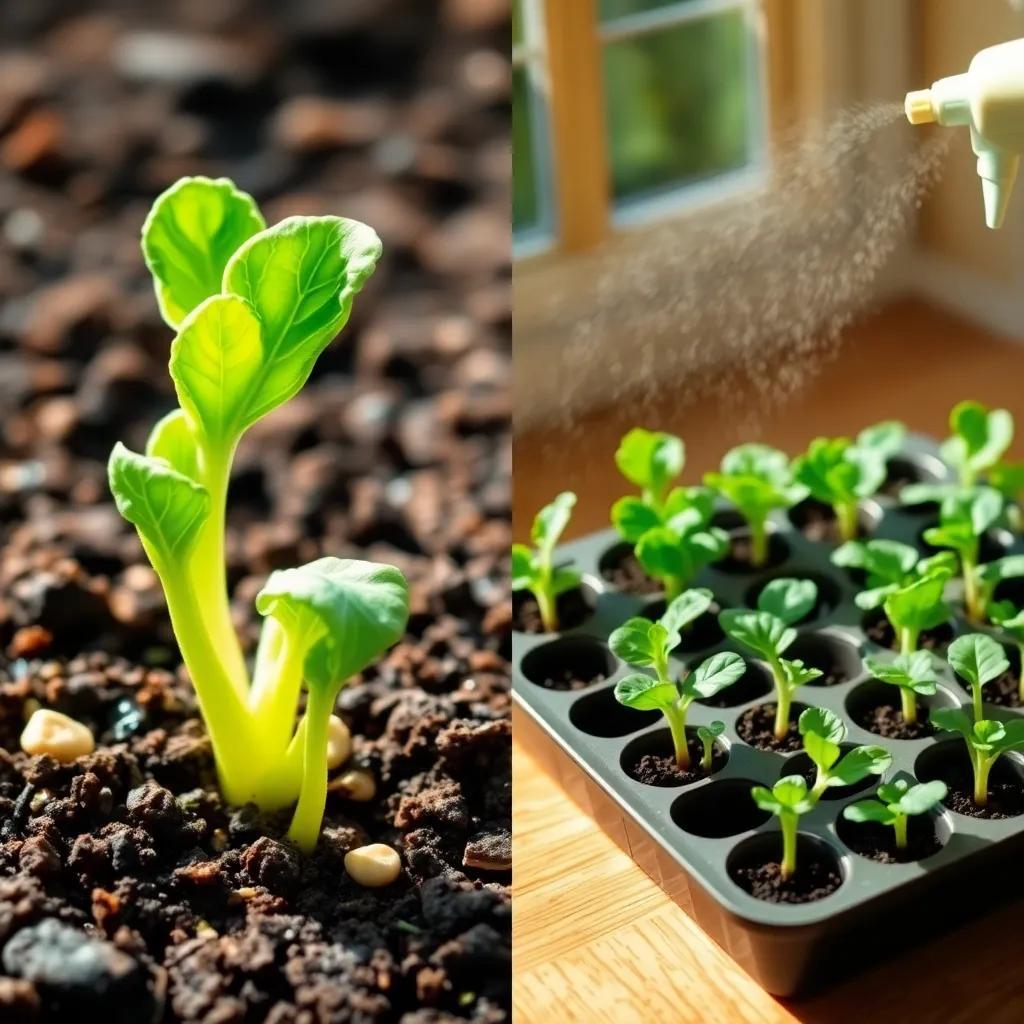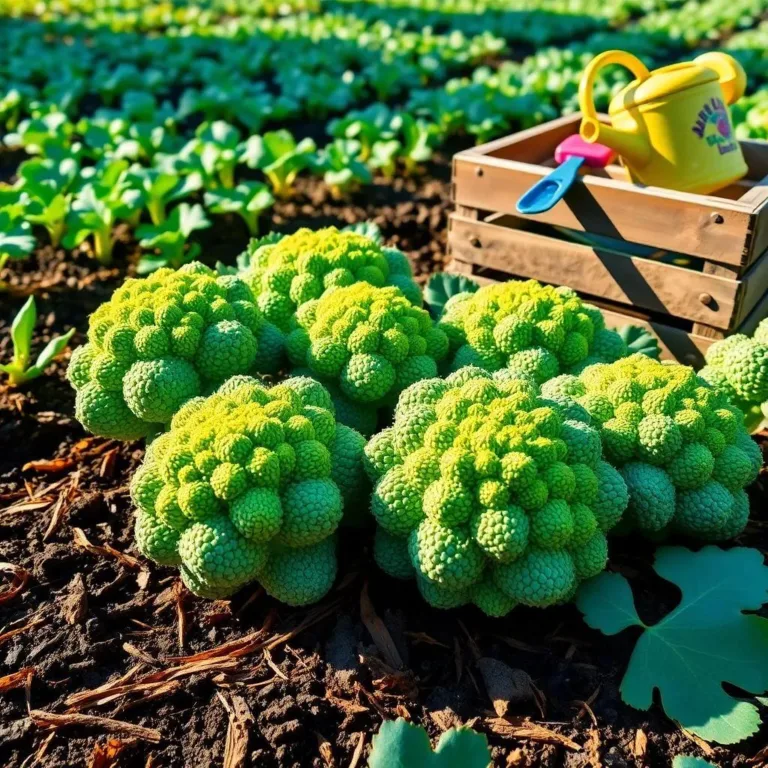Growing broccoli at home is an adventure I just can’t resist! From tiny seeds to delicious florets, every step of this journey is exciting and full of surprises. Are you ready to join me in discovering the secrets to growing your very own broccoli? Let’s dig in!
Understanding Broccoli Seed Germination Process
Germinating broccoli seeds is like waking them from a long nap! It’s an exciting process that kickstarts the journey to delicious broccoli on your plate. So, let’s break it down into simple steps to get those seeds sprouting!
- Seed Selection: It all begins with picking the right seeds. I like to choose high-quality seeds from a trusted supplier. Fresh, healthy seeds will give you the best chance for a bountiful harvest! If you can, go for hybrid varieties. They tend to be tougher against diseases!
- Preparing the Seedbed: Before we can plant, we need to create a cozy home for our seeds. Whether you’re using a raised bed or seed tray, make sure the soil is loose, well-drained, and rich in organic matter. Think of it like giving your seeds a comfy bed to sleep in!
- Sowing the Seeds: Time to plant! Follow the instructions on your seed packet for the right spacing. Typically, sow them about ¼ to ½ inch deep. I like to make little holes or furrows in the soil and drop in a seed or two. It’s like tucking them in for the night!
- Watering and Moisture: After planting, give the seedbed a gentle drink. Keep the soil moist but not soggy, kind of like keeping a sponge damp. I like to mist the surface lightly. Check daily to make sure those little guys stay happy!
- Germination Period: Most broccoli seeds sprout within 5 to 10 days, but sometimes they can take up to two weeks. Be patient; it’s worth the wait! You’ll know they’re awake when the seed coat splits and tiny leaves pop out.
By following these steps, you’ll be on your way to growing strong and healthy broccoli seedlings! Isn’t it exciting to think about soon seeing those little plants? Hang on tight; the next part is even more fun!
Key Steps for Successful Seedling Development
Once those little seedlings poke their heads out of the soil, it’s time for their big adventure: seedling development! This phase is super important because it helps lay the foundation for healthy, strong broccoli plants. Here’s how to help them thrive!
- True Leaves: After the initial leaves, called cotyledons, the seedlings will start growing true leaves. These new leaves are the real deal and help the plant breathe and eat through photosynthesis! Make sure to give them a nice sunny spot to soak up all that light.
- Thinning Seedlings: If you’ve got a few too many sprouts, you need to thin them out. I know it’s tough, but having too many seedlings can crowd them. Aim for about 12-18 inches between each plant. This gives them space to stretch out and soak up nutrients!
- Watering: Keep your seedlings happy with regular watering. The soil should be consistently moist but not drowning. I like to check the soil every day. If it feels dry an inch down, it’s time for a sprinkle!
- Fertilization: To help them grow strong, feed your seedlings some balanced fertilizer. Just follow the instructions on the package, and be careful not to overdo it! We want our broccoli to grow, not turn into a leafy monster!
- Hardening Off: Before moving those seedlings outdoors, they need some practice in the real world! Gradually introduce them to outdoor conditions over a week or so. Start with a few hours in a sheltered spot, then slowly increase their time outside. This helps them get used to sun and wind!
Just like that, you’re nurturing your broccoli from little sprouts into sturdy plants! Isn’t gardening just the best? Keep an eye on them, and soon enough, you’ll be moving to the next exciting stage—transplanting!

Transplanting Broccoli: Timing and Techniques
After nurturing those little seedlings, the next step is transplanting them into the garden! This is a big moment for our broccoli plants, and timing is everything! Here’s what I’ve learned about how to do it right.
- Timing: The best time to transplant broccoli seedlings is when they are about 4 to 6 weeks old and have at least a couple of true leaves. It’s also important to wait until the frost danger has passed. I always check my local frost dates; it can be tricky, but nobody wants their little plants to get nipped by cold weather!
- Preparing the Garden Bed: Before transplanting, I like to prepare the garden bed nicely. I mix in some compost or well-rotted manure to give the soil a nutrient boost. The soil should be loose and crumbly, not too hard or compact—broccoli loves to stretch its roots!
- Planting Technique: When it’s time to transplant, I gently lift each seedling from its tray, being careful not to disturb the roots. I then dig a hole in the garden bed that’s wide enough for each seedling’s roots to spread out comfortably. It’s important to plant them at the same depth they were growing in their trays.
- Spacing: I space my broccoli plants about 12 to 18 inches apart. This allows them to grow big and strong without fighting for sunlight or nutrients. Think of it like giving each plant its own space to stretch out!
- Watering After Transplanting: Once the seedlings are in the ground, I give them a good watering to help them settle in. A little extra care right after transplanting can make a big difference!
Now that our seedlings are firmly planted in their new home, we can look forward to watching them grow into delicious broccoli heads!
Growth Stages of Broccoli: From Seedling to Harvest
Watching broccoli grow is like witnessing a mini miracle! These plants go through several exciting growth stages before they reach the harvest point, and each stage is important for producing those tasty florets.
- Seedling Growth: After transplanting, the seedlings continue to grow. They’ll develop even more true leaves and establish a strong root system. This stage usually lasts about 4 to 6 weeks. Make sure to keep the soil consistently moist and provide plenty of sunlight. I love seeing them stretch up toward the sky!
- Vegetative Growth: Next, the plants enter the vegetative growth stage. During this time, they focus on producing lots of foliage. The plants will grow bigger and bushier, with lush green leaves that help capture sunlight for energy. This is when we want to ensure they get enough nutrients and water.
- Head Formation: Around 60 to 85 days after transplanting, the plants start forming heads! It’s like broccoli magic happening right before our eyes! The heads will begin to swell, and it’s critical to monitor them closely. The perfect time to harvest is when the buds are tight and firm, just before they start to open.
- Harvesting: Once the heads reach that perfect size, it’s time to cut! I like to harvest in the morning when they’re freshest. It’s easy to cut the main head, and don’t forget to check for those delicious side shoots!
- Post-Harvest Growth: After you cut the main head, your broccoli plants can keep producing side shoots. Regularly harvesting these shoots will give you a longer harvesting period!
By understanding these growth stages, I feel more connected to my broccoli plants, and I can take better care of them for a fantastic harvest!
Tips for Maximizing Your Broccoli Harvest
If there’s one thing I’ve learned about growing broccoli, it’s that a few simple tips can make all the difference in getting a bountiful harvest! Here are my top suggestions for making the most out of your broccoli crop.
- Planting at the Right Time: I always aim to plant my broccoli seeds in early spring or late summer. Broccoli loves cooler temperatures, so timing is key! Avoid planting during the hot summer months to keep your plants happy.
- Soil Quality: Good soil makes happy broccoli! Adding organic matter like compost not only nourishes the plants but also improves soil drainage. I always try to mix in some compost before planting to kickstart the season!
- Regular Watering: Consistent moisture is essential. I like to make sure my broccoli gets about an inch of water each week, especially during dry spells. Over or under-watering can stress the plants and affect growth. I check the soil regularly to keep it just right!
- Pest Control: Keep an eye out for pests that love to munch on broccoli! Aphids and cabbage worms can be trouble. I prefer using organic pest control methods whenever I can to protect my crop without harmful chemicals.
- Harvesting Regularly: As I mentioned before, don’t just pick the main head! Regularly harvesting side shoots encourages the plant to keep producing. Plus, it’s a great way to enjoy fresh broccoli longer!
With these tips, I’m excited to cultivate a thriving broccoli garden! Watching those plants grow and seeing my hard work pay off is honestly the best feeling ever!

